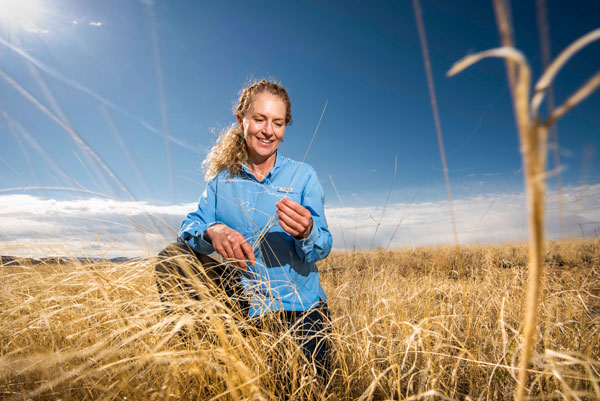Ecologist plans land makeovers, protects environment

On a drive around the Labs, ecologist Jennifer Payne sees more than wide-open desert, grasslands, cacti and dirt. She notices tiers of soil that have gone through stress, peers closely at the height and spacing of vegetation and recites the Latin names of native New Mexican plants and where they belong.
“No matter where I am, I’m always looking at the vegetation,” Jennifer said. “It’s like people who are into birding. Everywhere they are, they’re looking at birds. Everywhere I am, I’m looking at vegetation.”
Jennifer is a Sandia ecologist who stabilizes degraded lands. She is also one of two Certified Ecological Restoration Practitioners in New Mexico, a title held by only 150 people in the country. She was awarded the certification in 2017 by the Society for Ecological Restoration, an international organization of researchers, practitioners and leaders.
Having an ecologist who specializes in restoration ensures Sandia upholds commitments to protect land leased from Kirtland Air Force Base and land withdrawn from the U.S. Forest Service.
“At some point in time, some of that land may be turned back to either of those entities,” said Sandia ecology team lead Steve Cox. “As opposed to having land with Russian thistle and tumbleweeds, we have an obligation to protect the land and return it to the way we got it.”
Helping all species, furry arachnids included
Driving to a restoration project, Jennifer pulls over her truck, grabs a plastic cup and runs out to capture and move a tarantula from the road to a safe spot among native grasses. Sandia lands are home to lizards, snakes, birds and other wildlife that ecologists monitor and protect.
Even furry arachnids deserve help, according to Jennifer. “Reestablishing the natural habitat stabilizes the soil and benefits wildlife that quickly begin to use the area for cover, forage and breeding.”
Sandia construction projects larger than an acre must have a Stormwater Pollution Prevention Plan and comply with a construction permit issued by the U.S. Environmental Protection Agency. Stormwater runoff from construction sites can cause significant erosion and degradation of local water bodies due to sedimentation, Jennifer said.
The EPA permits can’t be terminated until 70% of the preexisting native vegetation cover has been reestablished across the project area, or the soil is stabilized with gravel.
Pouring seeds, not rocks
While complying with the permits is not unique to Sandia, the ecology team works to revegetate rather than just pour rocks.
Native vegetation looks better, is cooler in the summer and prevents unwanted weeds from overtaking the area, which can happen in unmaintained graveled areas, Jennifer said.
“I think gravel is commonly used on projects outside Sandia because reestablishing native vegetation requires specialized knowledge that not all construction companies have.”
Native vegetation is incredibly resilient, and provides permanent soil stabilization without maintenance, she said. It can withstand weather extremes from droughts to intense monsoons, from frigid temperatures to heat waves. It’s also better for animals.
“We’ve got a lot of land that is protected from urbanization and we’ve got a lot more wildlife than people realize,” said John Kay, Sandia’s stormwater program lead. “We’re not in the business of creating a nature preserve, but in a way we kind of have one out here.”
Blending in
Walking through a field at the base of the Manzano mountains, Jennifer stops to examine native grasses planted where heavy equipment was used to clean up large concrete structures. She created a reseeding plan for the area and now the new grass blends in.
At any given time, Jennifer works on multiple restoration plans and monitors sites that have been reseeded. She said John and his stormwater program will let her know when a project requires a stormwater permit in addition to reseeding.
Each site requires a slightly different methodology based on project constraints, microclimates, slopes and other project-specific factors, Jennifer said. Restoring degraded sites in central New Mexico is extremely challenging, with an average of just nine inches of precipitation a year, drying spring winds, hot summers and cold winters.
She provides her plans for each site to Sandia’s facilities group, which hires subcontractors to reseed the area. Because she’s not completing the hands-on reseeding, her plans must be extremely specific. John added that everyone involved is very thoughtful and careful in how Sandia completes revegetation.
“I think people would be surprised and impressed to know the lengths we go to protect the environment,” John said.